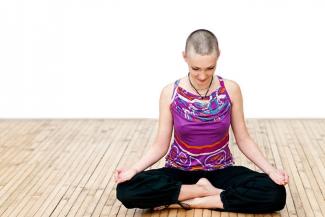
According to a study being conducted by the Tata Memorial Centre in Mumbai, yoga has a positive impact on breast cancer survivors, especially in domains related to fatigue, emotional score, pain management, compliance to treatment and improves overall quality of life. An interview with Dr Nita Nair who led the study.
The Department of Surgical Oncology, Breast Disease Management Group and Tata Memorial Centre (TMC) in Mumbai recently undertook a study on cancer and yoga. The study was led by you and your colleagues. Could you tell us a little about it?
The study is a randomized controlled trial designed to address the impact of yoga on both Quality of Life (QOL) and disease free survival in women undergoing standard treatment for breast cancer.
This study is the brain child of our Director, Dr. R. A. Badwe and Ms. Nishu Singh Goel. It is among the largest randomized studies, which will accrue 850 women to the addition of Yoga versus not while on treatment for breast cancer. One group undergoes yoga with routine treatment one group has only routine treatment. The study started in 2010, we have accrued 743 women on the study to date and the current report on the impact of yoga on the quality of life analysis has been reported in 605 of the enrolled women. This is a longitudinal study measuring various phases of yoga during treatment and survivorship, with a comparative analysis of different time points and the response to yoga, which will help integrating yoga as a complementary modality. Also, this study will help identify the long term and short term effects of this therapy in breast cancer patients and survivors. This study is still ongoing and the final analysis on survival will be available 5 years from the accrual of the last patient.
What was the sample size and how long did it take to complete the study?
The sample size is 850 and the study is still ongoing. We have accrued 743 women on the study to date and the current report on the impact of yoga on the quality of life analysis has been reported in 605 of the enrolled women. This study is still ongoing and the final analysis on survival will be available 5 years from the accrual of the last patient.
Was there any specific reason to focus only on non-metastatic (non-spreading) breast cancer?
Women with metastatic breast cancer especially bone metastasis, may have more restrictions to performing exercises and other concerns. Also, we were looking for an improvement in cure rates as well as QOL.
What was the analysis of your study?
Yoga showed numerically better scores in all aspects of QOL, which reached statistical significance in domains related to fatigue, emotional score, pain score and improved compliance to treatment. In overall quality of life, 52% women on yoga showed an improvement from baseline compared to 42% in the control group. The final results on impact of yoga on breast cancer survival are not yet ready as the study is still accruing patients.
How did women with breast cancer benefit with yoga?
Yoga showed numerically better scores in all aspects of QOL, which reached statistical significance in domains related to fatigue, emotional score and pain score.
Yoga is a low-risk, low-cost, complementary therapy that may improve compliance to therapy by improving parameters that can affect day-to-day activity in women with breast cancer.
There is an increasing body of work that shows that yoga can help prevent and better manage cancer, and other ailments. In what ways was your study different?
There have been numerous retrospective and prospective (but not robust) studies that have evaluated the impact of yoga on quality of life in women undergoing treatment for breast cancer. This is the first randomised controlled trial of this magnitude (850 women), which in addition to testing the impact of yoga on QOL is also powered to evaluate the impact of yoga on cure rates.
This is a longitudinal study measuring various phases of yoga during treatment and survivorship, with a comparative analysis of different time points and the response to yoga, which will help integrating yoga as a complementary modality. Also, this study will help identify the long term and short term effects of this therapy in breast cancer patients and survivors
Does Tata Memorial Hospital provide or prescribe yoga to its patients?
At present, only within the trial setting, as this is an ongoing study.
Are there any particular yoga asanas that you would recommend to survivors of breast cancer?
The modules in this study are carefully designed by Ms. Goel, keeping the phase of treatment or recovery of the patient / survivor in focus. The module begins with breathing exercises (Pranayam) and follows on to mobility related exercises. Chronic ailments which may impede flexibility or mobility have also been accounted for with modifications suggested in those situations. The concerns about restrictions in movement due to other chronic ailments, etc. need to be addressed in clinical practice when recommending yoga as a complimentary therapy.






